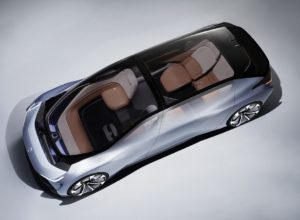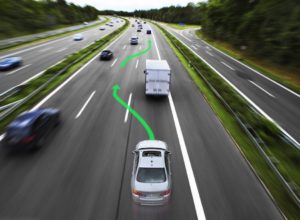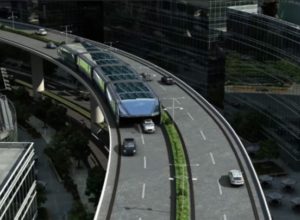Tag: Transportation
New Paradigms in Mobility
When we think for a minute about mobility and transportation, it is a thing so ordinary and habitual to our lives that we don’t even realize how essential it is.
If we think about what our lives would have been without access to mobility and transportation, to say we’ll have quite a challenging day wouldn’t be enough to portray what a day without these facilities would look like. Even more, to the present-day, so accommodated to technology generation.
The Managing Partner at New Mobility Consulting Alexander Renz presented his vision on the future of mobility at Webit.Festival 2017 in Sofia. One of the trends in mobility is connected vehicles. Vehicles become connected, these connected vehicles become part of the Internet of Things, which implies quite a lot of security risks, but also opportunities to deliver new services to the vehicle and customers. Another trend is autonomy, the role of AI self-driving cars, drones, and who knows where it’ll end. A future of cars driving around looking for passengers to pick up or to deliver goods from town to town is not unimaginable at all.
Thanks to Elon Musk we’re on the way to accomplish zero emission mobility, enabled by electric cars and infrastructure. It doesn’t only concern about creating the vehicle but a complete system with energy generation, electric charging infrastructure and the vehicles adapted to the new system.
The major problems in cities - parking, deliveries, ticketing, faster and better transportation and infrastructure are all on the table of resolving. The key thing is, that this is no longer a world where technology plays a role in making things better but it’s a complete technology driven transformation of a critical sector.
This transformation of mobility will impact a lot of different industries.
The model of owning a car has been already challenged since the birth of Uber, Lyft and other examples of the sharing economy. Once we're ready and sit in our self driving vehicles, the monetization model of the future would be very different from today - the use of Internet services, the type of content we'll consume in in our added spare time while we don't have to drive. Mobility and transportation is an industry being heavily disrupted and has yet to be disrupted, still.California gives way to the self-driving future with new legislation
The last few decades shattered the myth that research and development of high technology is not possible without state support. But still in some cases the disruptive advances that are transforming whole industries can’t happen without disruptive legislation.
Last week California’s Department of Motor Vehicles announced that automakers and tech titans will be allowed to test their fully autonomous cars in the state. Many in the automotive industry thinks that although California is the go-to destination for development of self-driving technologies, the rules established right now are holding research back.
The new proposed regulations eliminates the need for human drivers in the car during the test drives. This means that the companies will no longer have to equip vehicles with steering wheels.
With the new set of rules, road testing of autonomous vehicles could begin by the end of the year, while the first real models could become available in the market in 2018.
According to the law professor at the University of South Carolina Brian Walker Smith California has taken a big step towards the development of a real self-driving car. While many define the new rules as industry-friendly, experts from the automotive sector are confident that they will make our experience on the road much safer than it is today.
Just for a week, the Self-Driving Coalition for Safer Streets doubled its membership. The alliance, founded in 2016 by Lyft, Uber, Ford, Volvo and Waymo now includes not just car manufacturers, but also organizations, that have a real stake in the implementation of this new kind of mobility. Among them are Mothers Against Drunk Driving, National Federation of the Blind, United Spinal Association, the R Street Institute and Mobility 4 All.
Yesterday, the Chinese manufacturer NIO showed its concept consumer autonomous vehicle - the NIO EVE. The company is backed by several venture capital firms from China and has hired experts from the biggest brands in the industry, such as Tesla, Lyft and Ford.
EVE is a look at NIO’s vision for the future of autonomous vehicles. The interior was the main focus for the designers. It offers various options for entertainment while riding and series of smart displays.
The company’s intention is to bring the car to the US market by 2020. It will have a range of more than 960 kilometers, and with just a ten minute charge you will be able to travel additional 320 kilometers.
To learn about the latest trends in the world of Mobility and Transportation, visit Webit.Festival Europe in Sofia on April 25th and 26th. During the Mobility Summit you can listen to top level lecturers like the Managing Partner at New Mobility Consulting Alexander Renz, the Oracle’s Digital Director for EMEA Luisella Giani, the Director of International Transportation and Government at Xerox Richard Harris, the Managing Director of Startupbootcamp Smart Transportation and Energy Tanja Kufner and the Director for Urban Development at Siemens Julie Alexander.
Imagine a world, where cars are looking for passengers and deliveries...
As we approach Webit.Festival our team is starting series Q&A with our speakers. We are presenting you the first sessions with Alexander Renz, who will speak during the Mobility track of our Smart Cities Summit.
As Managing Partner at New Mobility Consulting, Alex Renz helps corporations, startups and investors take advantage of the opportunities emerging from the digital transformation of transportation and mobility, or New Mobility for short. He explores the transformative impact of connected vehicles, autonomous driving, electric mobility and on demand mobility services and fosters cross-industry collaboration across the emerging New Mobility ecosystem.
How will big automotive corporations cope with the changing world of mobility?
The Automotive industry is facing challenges on multiple fronts.
The shift towards electric mobility will make decades of engineering know how in building combustion engines obsolete. It will also require a lot less workers to build electric vehicles, both at the original equipment manufacturers (OEMs) and at their supplier networks.
The other big changes are connectivity and the vehicle as part of our digital lifestyles. Consumer experiences and data-driven business models will become more and more important, both things that the incumbents are not very good at.
But the biggest changes will emerge from driverless vehicles. We believe that driverless cars will have the most profound impact, not only on the car industry itself, but smart cities and real estate, public transport and insurance carrier to name a few.
When will we see the full-scale influx of self-driving vehicles?
The industry is making fast progress towards Level 3 and Level 4 Autonomous Driving, but it will probably take longer than most people expect before we have full Level 4 (NHTSA) automation where no driver is required at any time and the system can handle all driving situations autonomously.
However, with Level 3 we will see vehicles that can drive in a fully automated fashion without the need for a driver in defined use case scenarios. The most likely initial scenarios will be around trucks on highways. For the foreseeable future a driver will steer the truck as soon as it gets off the highway. The other big initial wave will likely be ride hailing, driven by players such as UBER and Lyft as well as the OEMs themselves, who transform into Mobility Services providers.
Even though several OEMs have announced fully autonomous production vehicles for ride hailing by 2021 it remains to be seen if that will happen. Especially in cities there are a myriad of driving situations that will challenge the capabilities of robot cars. As much as I am optimistic that these challenges can be addressed, there are regulatory hurdles that need to be overcome.
How can the industry monetize the wealth of data generated by connected and autonomous vehicles of the future?
Vehicles today are already loaded with sensors that generate massive amounts of data. However, until now the use of these sensors was focused on optimizing the internal functions of the car. Autonomous, connected vehicles will gather a lot of information about the vehicle itself, but also the driver and the environment. The debate as to who owns this data is still ongoing. There are huge data privacy implications and especially the German OEMs are very sensitive to protecting their customer’s privacy.
The big challenge for the industry is to develop relevant services that create brand loyalty and consumer engagement. Building relevant, contextual services is difficult, but even harder will be to build services that enough customers are willing to pay for to really matter for OEMs. The Internet services players will have a big advantage here, since their existing services easily translate into the driverless vehicle.
I believe that OEMs have a great opportunity if they can manage to combine engineering with digital competencies. They need to learn to design great user experiences and develop data science expertise to harness the data generated by the vehicle. In my view the car will need to become a platform for an ecosystem of services providers, much like we know it from mobile phones. Unfortunately they have relied heavily on suppliers and have given up to much control over what becomes a key strategic battleground.
Today’s connected car platforms are legacy technology and the mindset of OEMs continues to be that of a closed system. But there are interesting startup emerging that empower OEMs to develop new business models and increase agility without compromising on security and compliance.
What is the most significant technology that will shape the future of mobility in your mind?
If I had to pick a single exponential technology, I would say Artificial Intelligence in view of its importance for both automated driving, and digital assistants. However, ultimately it is not about a single exponential technology, but the convergence of technologies such as smart sensors networks, artificial intelligence and autonomous robotic systems.
We envision a world where robots such as cars become their own economic agents and will look for passengers and deliveries to generate revenues. Smart contracts on the blockchain will enforce maintenance and insurance policies, govern fares and pay taxes based on actual for road usage. In such as Machine-to-Machine (M2M) economy we will have autonomous vehicles transact with charging stations and other network participants without human intervention.
We need a next generation Internet to enable such networks to scale securely. We believe the blockchain has a big role to play in this next generation Internet. It provides a trusted, network-based identity, but also as an asset management and transaction layer. In many ways the blockchain will enable IoT, autonomous robotic systems and artificial intelligence to take us into the future of mobility. That is the core of my session at Webit.Festival in Sofia.
Here you can see a full list of the confirmed speakers at Webit.Festival, while here you can get all the information you need about the tickets for the event.
The future of cars is green, shared and autonomous
The debate about self-driving cars is already over. They are coming and the important question is who is going to build them first and how they will be regulated.
Nowadays there are more than 20 companies, from traditional giants in the automotive industry to new startups, who are trying to build autonomous car by the beginning of the new decade. And hundreds of others, who work on creative solutions for the new opportunities, that the self-driving cars present.
The dedication of Tesla’s CEO Elon Musk to developing autonomous vehicles is not new. But as the company is now testing its self-driving cars on public roads in California the idea is looking more like reality, than just a project.
But before we get to the implementation of this fascinating technology, we must look at changing need of car ownership. According to KPMG’s study 59% of industry bosses believe that more than half of all car owners today will no longer want to own a car by 2025.
The automation systems of the future will empower us to make the choice whether to drive on our own, or enjoy our automobile journeys as passengers. And instead of today’s car ownership model, we will most probably rely on the idea of mobility as a service by the end of the next decade.
And while most of us imagine that the future of automotive industry is fully committed to the electricity, the senior director of NVIDIA Danny Shapiro does not agree with this statement.
“We have a projection that by 2025, globally 15% of vehicles are going to have an electric component, whether that’s a pure electric vehicle, a plug-in hybrid or full hybrid. For western Europe, that percentage would obviously be higher”, Shapiro said in an interview for The Guardian.
He thinks that the huge oil infrastructure worldwide and the pro-oil administration in the United States in the next four years will slow down this process, or at least divert it to development of hybrid engines.
Meanwhile Japanese government is subsidising automakers, that create cars with hydrogen fuel cells, but the lack of infrastructure to support this new kind of fuel consumption will delay their implementation.
The common thing between all this technologies is the aim to transform the transportation into a more eco-friendly industry and lower its harmful emissions in line with the commitments in the Paris climate agreement, reached in the end of 2015.
If you want to keep up with the hottest trends in the world of mobility Webit.Festival is the right place for you. During our summits, you can listen to top level speakers such as the Director for International Transportation and Government in Xerox Richard Harris and the Managing Partner at New Mobility World Alexander Renz.
Smart cities are standing out, traffic jam fading
It’s morning rush hour. You are on your way to leave the kids at school and then to go to your office. There are hundreds of vehicles in front of and around you, you’re stuck in the traffic, but you listen to your favorite radio station, you’re in your own car and you already got used to it. That’s the current situation - traffic is unavoidable, you think.
But as cities nowadays get bigger and bigger, researches predict 70% of the world's population will live in cities by 2050. What does that mean? Crowded, polluted and an uncomfortable urban environment, a lot of you would quite reasonably imagine at first. But just here, the idea of smart cities comes to the rescue.
When looking forward to the bright tech future, we can think of connected technologies, ensuring a better quality of life, conscious use of natural resources, instant communication and bettering of all that needs to be bettered.
Imagine sensors showing you whether there are free spots on the parking lot, technologies limiting the water you’ve unconsciously wasted and cameras identifying the thief who has just stolen your bag. Imagine, but with your eyes open - in the years ahead, these appliances won’t be dreams, but reality. And not just in the big, distant cities.
Just like with human brain whose full potential we don’t always use, by now urban cities use a very small part of their full capacity in terms of smart, friendly appliances and connected technologies. But it’s just the right time that this is going to change.
Now, why don’t you watch this video and think again about the morning rush hour?
What if you had this vehicle on your way to work? This ‘Straddling Bus’ was shown in action in the Chinese city of Qinhuangdao, in the Hebei province. The citizens have probably been reasonably shocked at first: The enormous vehicle-prototype “eating cars” which they’ve seen is around 22 meters long, 8 meters wide, around 5 meters tall. It provides 2 meters of underneath space for cars to travel and is able to carry up to 300 passengers. Maybe now this technology still feels too futuristic, but its creators and many others think it will give the perfect solution to overcome traffic.
While driven cars may still seem long-lasting for many customers, tech innovators show us self-driven automobiles are soon to be widely affordable.
While it may seem smart cities are only reflecting on humans’ lives, truth is technology connects to nature to help us save, not destroy it.
While many big cities’ governments already embrace the concept of being a smart city, there are a lot yet to be convinced.
To learn more on the topic of Smart cities and innovation, visit the Smart Cities Summit of Webit.Festival 2017 and hear the latest trends in Digital Transformation, Smart Mobility & Transportation, Smart Energy and many more.
Amongst the confirmed speakers is Erion Veliaj, the current Mayor of Tirana, thanks to whose efforts the city was awarded for successfully applying innovations in communication between government and citizens. You will also see on the scene Alexander Renz, Managing Partner at New Mobility World, who works towards a future where mobility is environmentally sustainable.




